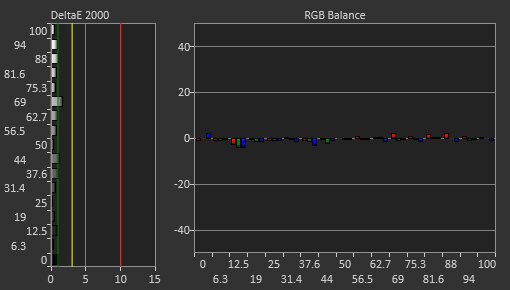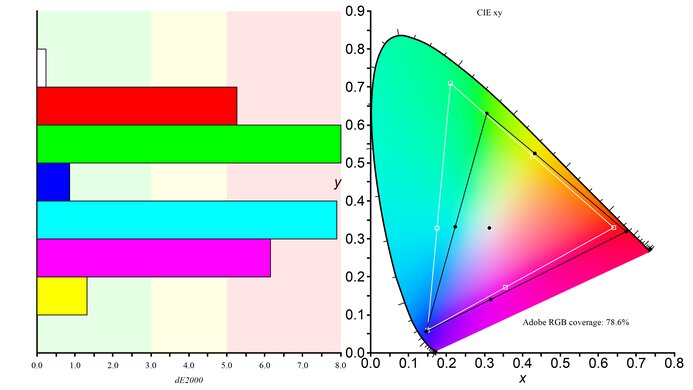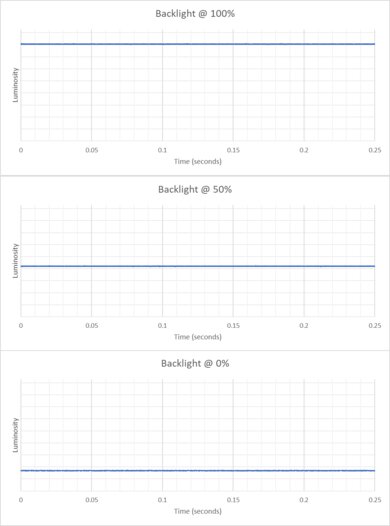The LG 27GR75Q-B is a 1440p 27-inch budget gaming monitor. It joins a number of other monitors in the 27-inch budget gaming segment, like the Dell G2724D. It's a lower-cost entry in LG's UltraGear gaming lineup and is less expensive than other UltraGear monitors like the LG 27GP850-B/27GP83B-B. However, it still provides a number of gaming features, like a 165Hz refresh rate and FreeSync and G-SYNC compatibility. To reach its budget price, it doesn't have many added features, like USB. However, it has some of LG's gaming-specific features, like a black stabilizer, crosshairs, and an FPS counter.
Our Verdict
The LG 27GR75Q-B is okay for PC gaming. It has FreeSync and G-SYNC compatibility to reduce screen tearing, and its 165Hz refresh rate is good enough for most gamers but not competitive gaming. It has low input lag for a responsive feel and a fast response time at high refresh rates, but it's worse at lower refresh rates as there's blur. However, its mediocre contrast causes deep blacks to appear gray in a dark room, and highlights don't pop in HDR.
- Fast response time at high refresh rates.
- Low input lag.
- Supports FreeSync and is G-SYNC compatible.
- Highlights don't pop.
- Low contrast makes blacks look gray in dark rooms.
- More blur and inverse ghosting at 60Hz.
The LG 27GR75Q-B isn't bad for console gaming. It has a fast response time at 120Hz, but it's slower at 60Hz, as there's more blur and inverse ghosting. It also can't take full advantage of the PS5 and Xbox Series X|S due to the lack of HDMI 2.1 bandwidth, but it still works with most signals with either console. It also has low input lag for a responsive feel while gaming. Unfortunately, though, it has limited picture quality as blacks look gray in the dark, and colors aren't vivid.
- Fast response time at high refresh rates.
- Low input lag.
- Can't take full advantage of consoles.
- Low contrast makes blacks look gray in dark rooms.
- More blur and inverse ghosting at 60Hz.
The LG UltraGear 27GR75Q-B is decent for office use. It has good text clarity, and its 27-inch screen is large enough to open two windows side by side. It also has good brightness, so it can overcome glare unless you're in a very bright environment. However, it can't swivel, so sharing your work with a colleague is more difficult.
- Bright enough to fight glare in most well-lit rooms.
- Wide viewing angles.
- Good text and image clarity.
- Doesn't swivel.
- No USB hub.
Distracting reflections in really bright rooms.
The LG 27GR75Q-B is okay for content creation. It has good text clarity, and you can open two windows side by side due to its large 27-inch screen. However, it only has satisfactory color accuracy before calibration, and you need to calibrate it for the most accurate colors. Additionally, it displays a limited range of HDR colors, so it can't display some colors if you're editing photos or videos in a wider gamut. It also can't swivel, so sharing your screen with colleagues is more difficult.
- Bright enough to fight glare in most well-lit rooms.
- Wide viewing angles.
- Good text and image clarity.
- Doesn't swivel.
- No USB hub.
- Needs full calibration for most accurate colors.
Distracting reflections in really bright rooms.
The LG 27GR75Q-B has okay brightness. While it's bright enough to fight glare in most well-lit rooms, it can't overcome glare in really bright environments. It also doesn't make highlights pop in HDR.
- Bright enough to fight glare in most well-lit rooms.
- Highlights don't pop.
The LG 27GR75Q-B has a good response time. Its response time is fast at high refresh rates, but there's more motion blur at lower refresh rates.
- Fast response time at high refresh rates.
- More blur and inverse ghosting at 60Hz.
The LG 27GR75Q-B is terrible for HDR. It has a low contrast ratio, so blacks look gray in dark rooms, and it lacks a local dimming feature. It also fails to make colors look vivid.
- Low contrast makes blacks look gray in dark rooms.
- Lack of local dimming feature.
The LG 27GR75Q-B has okay picture quality in SDR. Its main strength is that it displays a wide range of colors, but blacks look gray in dark rooms due to its low contrast.
- Low contrast makes blacks look gray in dark rooms.
The LG 27GR75Q-B has good color accuracy. However, you need to calibrate it for the best accuracy as colors are oversaturated before calibration.
- Good gray uniformity.
- Needs full calibration for most accurate colors.
Performance Usages
Changelog
- Updated Nov 10, 2025: We've converted this review to Test Bench 2.1.1. We removed the Vertical Viewing Angle test.
-
Updated Jul 14, 2025:
We updated text throughout to match the new and updated tests with Test Bench 2.1, including in the Verdict section.
- Updated Jul 10, 2025: We've converted this review to Test Bench 2.1. This includes new tests for Direct Reflections, Ambient Black Level Raise, and Total Reflected Light. You can see all the changes in the changelog.
- Updated Feb 21, 2025: We've converted this review to Test Bench 2.0.1. This includes a new test result for DisplayPort 2.1 Transmission Bandwidth.
Check Price
Differences Between Sizes And Variants
We tested the 27-inch LG 27GR75Q-B, which is the only size available for this monitor. The full model code may change between regions and retailers, and the results are only valid for this model.
| Model | Size | Resolution | Panel Type | Refresh Rate |
|---|---|---|---|---|
| 27GR75Q-B | 27" | 1440p | IPS | 165Hz |
Our unit was manufactured in November 2023; you can see the label here.
Popular Monitor Comparisons
The LG 27GR75Q-B is a decent budget gaming monitor. Its 165Hz refresh rate is good enough for most entry-level gamers, and fast-moving objects look crisp. However, there are better gaming choices you can get for a low cost, like the LG 27GP850-B/27GP83B-B, which has a higher max refresh rate of 180Hz and USB ports but costs more. Even the Dell G2724D is another good choice as it gets brighter than the 27GR75Q-B and has more consistent motion handling.
For more options, check out our recommendations for the best budget and cheap monitors, the best 1440p gaming monitors, and the best 27-inch gaming monitors.
The LG 27GR75Q-B and the Samsung Odyssey G50D S27DG50 are 1440p 27-inch gaming monitors. Both monitors are similar, and you may prefer to get whichever is less expensive. However, the Samsung is better if you plan to use the monitor in a bright room, as it gets much brighter.
The LG 27GR75Q-B and the LG 27GP850-B/27GP83B-B are 27-inch budget gaming monitors. However, the 27GP850-B/27GP83B-B performs better and is the better choice for most people. The 27GP850-B/27GP83B-B is better at overcoming glare, has a higher refresh rate, and displays fast-moving objects more crisply.
The LG 27GR75Q-B and the Dell G2724D are both 27-inch budget gaming monitors. However, the Dell is the better choice for most people. The Dell gets far brighter in HDR and SDR and is better at overcoming glare. The Dell also has better motion handling, so fast-moving objects look more crisp. Finally, the Dell supports VRR with the PS5, and the LG doesn't.
The LG 27GR75Q-B and the HP OMEN 27q are both 27-inch budget gaming monitors. The HP is the better monitor for PC gamers, as it has better gaming performance. The HP gets brighter in SDR and HDR, so it's better at overcoming glare. The HP also has significantly better HDR color gamut and volume, making colors more realistic and vivid. However, the LG is the better choice for console gaming, as it can display 4k @ 60Hz signals with the PS5 and HDR with the Xbox Series X|S, which the HP can't do.

We buy and test more than 30 monitors each year, with units that we buy completely on our own, without any cherry-picked units or samples. We put a lot into each unbiased, straight-to-the-point review, and there's a whole process from purchasing to publishing, involving multiple teams and people. We do more than just use the monitor for a week; we use specialized and custom tools to measure various aspects with objective data-based results. We also consider multiple factors before making any recommendations, including the monitor's cost, its performance against the competition, and whether or not it's easy to find.
Test Results

The ergonomics are decent. It has a good, smooth height adjustment system, so you can easily place it in your preferred position for a long gaming session. However, it can't swivel, so it's more difficult to share your screen with another person while co-op gaming or working. The stand features a hook for cable management.
This monitor has no local dimming feature. We still film these videos on the monitor so you can compare the backlight performance with a monitor that has local dimming.
The SDR brightness is good. It remains consistent with different content and gets bright enough to fight glare in a well-lit room. However, it has more trouble overcoming glare in brighter environments, particularly if the sun shines directly on the screen. These results are from after calibration in the 'Gamer 1' Game Mode, which is the picture mode setting, with the Brightness at its max and DFC turned off. If you're looking for a monitor that gets brighter, check out the Samsung Odyssey G5/G50D S27DG50.
The HDR brightness is mediocre. It doesn't get bright enough for highlights to pop against the rest of the image. Additionally, it has a slow roll-off towards its peak brightness, so highlights don't get the brightest they could. These results are in the 'Gamer 1' Game Mode in HDR with the Brightness at its max.
The accuracy before calibration is decent. Colors are relatively accurate but significantly oversaturated because the monitor lacks an sRGB mode to control the color gamut. Also, the color temperature is too cold, though the white balance is good. Finally, dark scenes are too dark, and bright scenes are too bright. There aren't any locked-out settings when using the 'Gamer 1' Game Mode.
The accuracy after calibration is remarkable, and you won't notice any problems.
This monitor has an incredible SDR color gamut. It can display the entire sRGB color space used in most content. However, it only has fair coverage of the wider Adobe RGB color space used in professional photo editing, and not all colors are accurate in that color space.
The HDR color gamut is decent. It has good coverage of the commonly used DCI-P3 color space, though white is quite inaccurate. However, it has poor coverage of the wider Rec. 2020 color space, and it can't display several colors accurately in this space.
The horizontal viewing angle is very good. It works well if you need to share your screen with someone sitting next to you, as they'll see a consistent image from the sides, though it washes out and gets darker at very wide angles.
The text clarity is good, and the text looks bolder with Windows ClearType (top photo) enabled. These photos are in Windows 10, and you can also see them in Windows 11 with ClearType on and with ClearType off.
The direct reflection handling is mediocre. The matte coating spreads light out, and it still has some noticeable mirror-like reflections.
The black levels don't rise in bright rooms, which is great. However, due to the monitor's low native contrast ratio, blacks still look gray even in a bright room.
Due to bandwidth limitations, the max refresh rate is limited over HDMI, but you won't have issues reaching that max refresh rate over DisplayPort.
| NVIDIA | VRR Min | VRR Max |
| DisplayPort | <20Hz | 165Hz |
| HDMI | N/A | N/A |
| AMD | VRR Min | VRR Max |
| DisplayPort | <20Hz | 165Hz |
| HDMI | <20Hz | 144Hz |
| Refresh Rate | CAD Heatmap | RT Chart | Pursuit Photo |
| 164 | Heatmap | Chart | Photo |
| 144 | Heatmap | Chart | Photo |
| 120 | Heatmap | Chart | Photo |
| 100 | Heatmap | Chart | Photo |
| 80 | Heatmap | Chart | Photo |
| 60 | Heatmap | Chart | Photo |
The LG 27GR75Q-B.AUS has good motion handling across its VRR range. The 'Normal' Response Time overdrive setting provides the consistently best performance, but it has more motion blur at lower refresh rates. The 'Faster' overdrive has such a high CAD that it passes the limits of the chart, and you can see it in an alternative chart here.
The refresh rate compliance is good. Although its response time isn't fast enough to make full color transitions before the monitor draws the next frame at its max refresh rate and at 120Hz, it's better at 60Hz.
| Overdrive Mode | CAD Heatmap | RT Chart | Pursuit Photo |
| Off | Heatmap | Chart | Photo |
| Normal | Heatmap | Chart | Photo |
| Fast | Heatmap | Chart | Photo |
| Faster | Heatmap | Chart | Photo |
The CAD at the max refresh rate of 165Hz is good, but there's still some motion blur. The 'Normal' and 'Fast' overdrive settings have a similar total response time, but 'Fast' has less motion blur, while the 'Faster' setting has too much inverse ghosting.
| Overdrive Mode | CAD Heatmap | RT Chart | Pursuit Photo |
| Off | Heatmap | Chart | Photo |
| Normal | Heatmap | Chart | Photo |
| Fast | Heatmap | Chart | Photo |
| Faster | Heatmap | Chart | Photo |
The CAD at 120Hz is good. Unlike at its max refresh rate, the 'Normal' overdrive setting provides the best motion handling, so you may have to switch the setting if you change games or sources. It has the quickest response time, but there's still some blur, and 'Fast' and 'Faster' have noticeable inverse ghosting.
| Overdrive Mode | CAD Heatmap | RT Chart | Pursuit Photo |
| Off | Heatmap | Chart | Photo |
| Normal | Heatmap | Chart | Photo |
| Fast | Heatmap | Chart | Photo |
| Faster | Heatmap | Chart | Photo |
The CAD at 60Hz is decent. There's noticeable blur and even inverse ghosting with the 'Normal' overdrive setting. If that bothers you, turning it off results in no overshoot, but it has more blur than using the 'Normal' setting.
| Refresh Rate | Motion Blur Photo |
| 165Hz | Photo |
| 120Hz | Photo |
| 100Hz | Photo |
This monitor supports backlight strobing to reduce persistence blur. While you can adjust the brightness, the maximum brightness level is only 64 cd/m², and the minimum brightness is 14 cd/m². Additionally, image duplication is enabled with this feature.
This monitor has low input lag for a responsive feel. Input lag doesn't significantly increase at low refresh rates or when you turn on backlight strobing.
| Connection | HDMI 2.0 | USB-C to DisplayPort |
| Max Refresh Rate | 144Hz | 165Hz |
| VRR Range | N/A | 48-165Hz |
| HDR | Yes | Yes |
The LG 27GR75Q works well with macOS. However, content looks washed out if you're using HDR over HDMI. If you're using a MacBook, windows return to their original position when waking the laptop up from sleep or reopening the lid.
The LG UltraGear 27GR75Q-B comes with a few extra features, including:
- Black Stabilizer: Allows you to adjust the black level so that you see opponents better.
- Crosshair: Provides different crosshair options to help assist with aiming.
- FPS Counter: Displays the frame rate of your input source.

































































